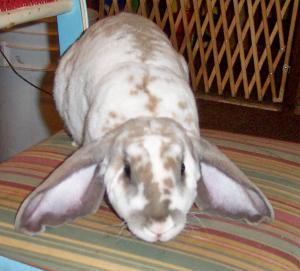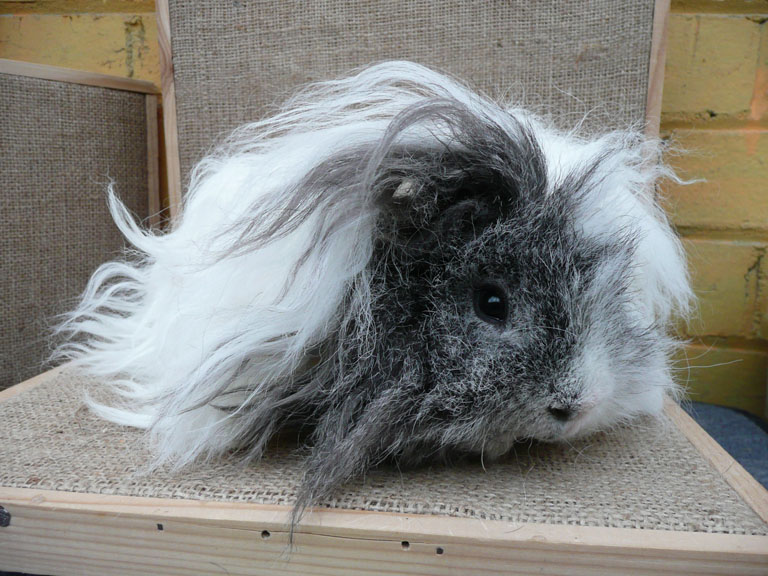|
| |
WEIGHT &TYPE Bold thickset and firm. The body should be
short, broad and well muscled with little visible neck. The well muscled rump is
short and well rounded. The chest is broad and deep with curved sides where it
meets the shoulders which are broad and strong. The front legs are short and
straight. The hind legs are short, strong, powerful and carried parallel to the
body. The tail is straight and well furred. A small dewlap is permissible in
adult does but not desirable
Adult Weight: Ideal 3.4 lbs, 1.5 kgs. Maximum 3.8 lbs, 1.60 kgs.
2 COAT The coat to be dense and of good length, roll back with
an abundance of guard hairs. Legs and pads to be well furred. A small amount of
extended fur around flanks is permissible on under five months exhibits
3 HEAD, EARS, CROWN, EYE & EYE COLOR The head is bold, broad and well
developed. The profile of the head is strongly curved with a good width between
the eyes, full cheeks and a broad muzzle. The eyes are bold, bright and large.
The basal ridge of the ears should appear prominent across the top of the skull
to form the crown. Ears should be broad, thick, well furred and rounded at the
ends. They should be carried close to the cheeks giving a horseshoe like outline
when viewed from the front. The inside of the ears should not be visible from
any angle when carried correctly.
4 MANE The mane should be between 2-3 inches in length to form a full circle
around the head, extending to a 'V' at the back of the neck falling into a
fringe between the ears.
5 COLOR Black - A deep solid black, carried well down hair shaft with blue/black
undercolor. Eyes dark hazel or black.
Blue -Deep or medium slate blue carried well down hair shaft with slate blue
undercolor. Eyes dark blue.
Agouti - Rich chestnut top color with black ticking over an intermediate orange
band with dark slate undercolor. Ears laced black. Eye circles, belly and
undertail white with slate blue undercolor. Pale top color a fault. Eyes deep
hazel.
Sooty Fawn - Even shade of orange/fawn to carry well down hair shaft to a
blueish white undercolor. Ears, belly, undertail to be blueish black (sooty),
cheeks and flanks to be shaded/topped with sooty tips. Eyes hazel.
Fawn - Bright rich fawn free of black/blue guard hairs, shading to a white
undercolor. Chest to match flanks. Eye circles, inside of ears, underside of
jowl, belly and undertail to be white. Black/blue guard hairs to be considered a
serious fault. Eyes hazel.
Black Fox - To be an even jet-black with undercolor as dark as possible
extending to the skin. The chest, flanks and feet to be well and evenly ticked
with silver-tipped guard hairs. Any extension of the ticking up the side and/or
over the back to be considered a beauty and not a fault. The eye circles as neat
as possible, a pea spot in front of the base of each ear. Inside of ears, line
of jaw, underside of tail and belly all to be white, undercolor permissible.
Triangle to be white but as small as possible. Eyes brown or grey.
Black Otter - Body colour to be lustrous black, uniform throughout, with slate
blue undercolor to reach skin. The belly and underside of the chin and tail to
be creamy white with blue or white undercolor, to be divided from the body color
by a distinct border of tan. Nostrils and nape of neck to be tan. Eye circles
and inside ears to be fawn. Chest to be a mixture of black and tan, merging with
the main body color. The fore feet on the front shall be predominantly black,
the tan border between belly and flanks shall be continued down to the hind
feet. Faults - brown or rust tinge to the body color. White or tan hairs other
than in the patterned area. Grey belly surface. Eyes brown.
NB: the color standard for the Otter is based on the Otter Rex, the remainder
are all based on the Dwarf Lop standard.
6 CONDITION The exhibit should be in a perfect state of health and bodily
condition, free from all soiling, particularly on the feet, ears and genital
parts. The coat should reflect the overall good health of the exhibit, which
should appear alert and vigorous
FAULTS Long coat on ears and body, excessively short or long mane, body too
long, head not sufficiently characteristic of breed, pimpled or damaged ears,
poor ear carriage, ears folded, crown not developed, fly back coat, large
dewlaps in does, rear feet not parallel to the body, light soiling of feet, ear
and genital organs, bare pads, fur slightly soiled or matted, long toenails,
lack of vitality.
DISQUALIFICATIONS Complete lack of mane, Maloccluded or mutilated teeth, over
weight limit, deformities and mutilations, deformation of the teeth, feet bowed
or bent, white toe nails in colored exhibits, crooked tail, any discernible
illness or disease, blindness or partial blindness, incorrect eye color, any
parasitic infection, much soiling, matted coat, sore pads (where skin is broken
or scabbed) any evidence of irregular preparation for exhibition including
trimming and dyeing |

